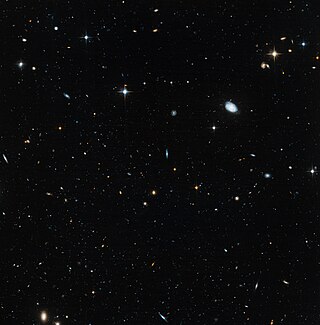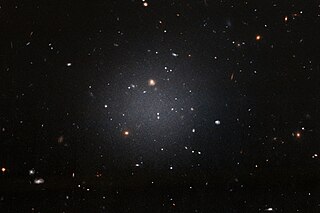
A globular cluster is a spheroidal conglomeration of stars that is bound together by gravity, with a higher concentration of stars towards their centers. They can contain anywhere from tens of thousands to many millions of member stars, all orbiting in a stable, compact formation. Globular clusters are similar in form to dwarf spheroidal galaxies, and the distinction between the two is not always clear. Their name is derived from Latin globulus. Globular clusters are occasionally known simply as "globulars".

The Local Group is the galaxy group that includes the Milky Way, where Earth is located. It has a total diameter of roughly 3 megaparsecs (10 million light-years; 9×1019 kilometres), and a total mass of the order of 2×1012 solar masses (4×1042 kg). It consists of two collections of galaxies in a "dumbbell" shape; the Milky Way and its satellites form one lobe, and the Andromeda Galaxy and its satellites constitute the other. The two collections are separated by about 800 kiloparsecs (3×10^6 ly; 2×1019 km) and are moving toward one another with a velocity of 123 km/s. The group itself is a part of the larger Virgo Supercluster, which may be a part of the Laniakea Supercluster. The exact number of galaxies in the Local Group is unknown as some are occluded by the Milky Way; however, at least 80 members are known, most of which are dwarf galaxies.

The Sagittarius Dwarf Spheroidal Galaxy (Sgr dSph), also known as the Sagittarius Dwarf Elliptical Galaxy, is an elliptical loop-shaped satellite galaxy of the Milky Way. It contains four globular clusters in its main body, with the brightest of them—NGC 6715 (M54)—being known well before the discovery of the galaxy itself in 1994. Sgr dSph is roughly 10,000 light-years in diameter, and is currently about 70,000 light-years from Earth, travelling in a polar orbit at a distance of about 50,000 light-years from the core of the Milky Way. In its looping, spiraling path, it has passed through the plane of the Milky Way several times in the past. In 2018 the Gaia project of the European Space Agency showed that Sgr dSph had caused perturbations in a set of stars near the Milky Way's core, causing unexpected rippling movements of the stars triggered when it moved past the Milky Way between 300 and 900 million years ago.

A dwarf galaxy is a small galaxy composed of about 1000 up to several billion stars, as compared to the Milky Way's 200–400 billion stars. The Large Magellanic Cloud, which closely orbits the Milky Way and contains over 30 billion stars, is sometimes classified as a dwarf galaxy; others consider it a full-fledged galaxy. Dwarf galaxies' formation and activity are thought to be heavily influenced by interactions with larger galaxies. Astronomers identify numerous types of dwarf galaxies, based on their shape and composition.
Ursa Major I Dwarf is a dwarf spheroidal galaxy that orbits the Milky Way galaxy. It was discovered in 2005 within the Ursa Major constellation and is the third least luminous known galaxy.

The Fornax Dwarf Spheroidal is an elliptical dwarf galaxy in the constellation Fornax that was discovered in 1938 by Harlow Shapley. He discovered it while he was in South Africa on photographic plates taken by the 24 inch (61 cm) Bruce refractor at Boyden Observatory, shortly after he discovered the Sculptor Dwarf Galaxy.
The Milky Way has several smaller galaxies gravitationally bound to it, as part of the Milky Way subgroup, which is part of the local galaxy cluster, the Local Group.

Terzan 7 is a sparse and young globular cluster that is believed to have originated in the Sagittarius Dwarf Spheroidal Galaxy and is physically associated with it. It is relatively metal rich with [Fe/H] = -0.6 and an estimated age of 7.5 Gyr. Terzan 7 has low levels of nickel which supports its membership in the Sag DEG system since it has a similar chemical signature. It has a rich population of blue stragglers that are strongly concentrated toward the center of Terzan 7. It has an average luminosity distribution of Mv = -5.05. It has a half-light radius (Rh) of 6.5pc.
Ursa Major II Dwarf is a dwarf spheroidal galaxy situated in the Ursa Major constellation and discovered in 2006 in the data obtained by the Sloan Digital Sky Survey. The galaxy is located approximately 30 kpc from the Sun and moves towards the Sun with the velocity of about 116 km/s. It has an elliptical shape with the half-light radius of about 140 pc.
Segue 1 is a dwarf spheroidal galaxy or globular cluster situated in the Leo constellation and discovered in 2006 by Sloan Digital Sky Survey. It is located at a distance of about 23 kpc from the Sun and moves away from the Sun with the velocity of about 206 km/s. Segue 1 has a noticeably elongated shape with the half-light radius of about 30 pc. This elongation may be caused by the tidal forces acting from the Milky Way galaxy if Segue 1 is being tidally disrupted now.

Leo IV is a dwarf spheroidal galaxy situated in the Leo constellation, discovered in 2006 in the data obtained by the Sloan Digital Sky Survey. The galaxy is located at the distance of about 160 kpc from the Sun and moves away from the Sun with the velocity of about 130 km/s. It is classified as a dwarf spheroidal galaxy (dSph) meaning that it has an approximately round shape with the half-light radius of about 130 pc.
Leo V is a dwarf spheroidal galaxy situated in the Leo constellation and discovered in 2007 in the data obtained by the Sloan Digital Sky Survey. The galaxy is located at a distance of about 180 kpc from the Sun and moves away from the Sun with the velocity of about 173 km/s. It is classified as a dwarf spheroidal galaxy (dSph) meaning that it has an approximately spherical shape with the half-light radius of about 130 pc.
Canes Venatici II or CVn II is a dwarf spheroidal galaxy situated in the Canes Venatici constellation and discovered in 2006 in data obtained by the Sloan Digital Sky Survey. The galaxy is located at a distance of about 150 kpc from the Sun and moves towards the Sun with the velocity of about 130 km/s. It is classified as a dwarf spheroidal galaxy (dSph) meaning that it has an elliptical shape with a half-light radius of about 74+14
−10 pc.
Coma Berenices or Com is a dwarf spheroidal galaxy situated in the Coma Berenices constellation and discovered in 2006 in data obtained by the Sloan Digital Sky Survey. The galaxy is located at the distance of about 44 kpc from the Sun and moves away from the Sun with the velocity of about 98 km/s. It is classified as a dwarf spheroidal galaxy (dSph) meaning that it has an elliptical shape with the half-light radius of about 70 pc.
Boötes II or Boo II is a dwarf spheroidal galaxy situated in the constellation Boötes and discovered in 2007 in the data obtained by Sloan Digital Sky Survey. The galaxy is located at the distance of about 42 kpc from the Sun and moves towards the Sun with the speed of 120 km/s. It is classified as a dwarf spheroidal galaxy (dSph) meaning that it has an approximately round shape with the half-light radius of about 51 pc.

Hercules, or Her, is a dwarf spheroidal galaxy situated in the Hercules constellation and discovered in 2006 in data obtained by the Sloan Digital Sky Survey. The galaxy is located at a distance of about 140 kpc from the Sun and moves away from the Sun with a velocity of about 45 km/s. It is classified as a dwarf spheroidal galaxy (dSph). It has a noticeably elongated shape with a half-light radius of about 350 pc. This elongation may be caused by tidal forces acting from the Milky Way galaxy, meaning that Her is being tidally disrupted now. Her also shows some gradient of velocities across the galaxy's body and is embedded into a faint stellar stream, which also points towards its ongoing tidal disruption.
Pisces II is a dwarf spheroidal galaxy situated in the Pisces constellation and discovered in 2010 in the data obtained by the Sloan Digital Sky Survey. The galaxy is located at the distance of about 180 kpc (kiloparsecs) from the Sun. It is classified as a dwarf spheroidal galaxy (dSph) meaning that it has an elongated shape with the half-light radius of about 60 pc and ratio of the axis of about 5:3.
Leo T is a dwarf galaxy situated in the Leo constellation and discovered in 2006 in the data obtained by Sloan Digital Sky Survey. The galaxy is located at the distance of about 420 kpc from the Sun and moves away from the Sun with the velocity of about 35 km/s. The velocity with respect to the Milky Way is around −60 km/s implying a slow infall onto the Milky Way. Leo T is classified as a transitional object between dwarf spheroidal galaxies (dSph) and dwarf irregular galaxies (dIrr). Its half-light radius is about 180 pc.

An ultra diffuse galaxy (UDG), or Dark galaxy, is an extremely low luminosity galaxy, the first example of which was discovered in the nearby Virgo Cluster by Allan Sandage and Bruno Binggeli in 1984. These galaxies have been studied for many years prior to their renaming in 2015. Their lack of luminosity is due to the lack of star-forming gas, which results in these galaxies being reservoirs of very old stellar populations.
The Eridanus II Dwarf is a low-surface brightness dwarf galaxy in the constellation Eridanus. Eridanus II was independently discovered by two groups in 2015, using data from the Dark Energy Survey. This galaxy is probably a distant satellite of the Milky Way. Eridanus II contains a centrally located globular cluster; and is the smallest, least luminous galaxy known to contain a globular cluster. Crnojević et al., 2016. Eridanus II is significant, in a general sense, because the widely accepted Lambda CDM cosmology predicts the existence of many more dwarf galaxies than have yet been observed. The search for just such bodies was one of the motivations for the ongoing Dark Energy Survey observations. Eridanus II has special significance because of its apparently stable globular cluster. The stability of this cluster, near the center of such a small, diffuse, galaxy places constraints on the nature of dark matter.










